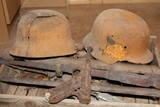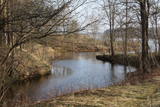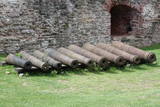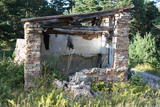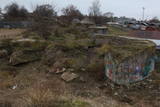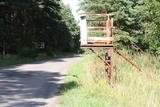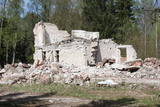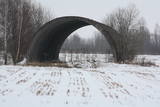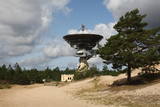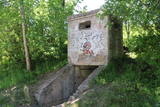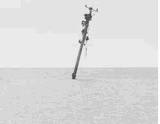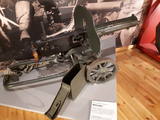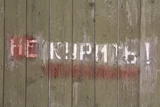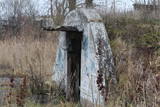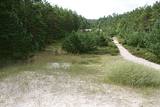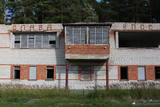| Nr | Name | Beschreibung |
|---|---|---|
|
In Ugāle im Haus Silmači ist ein kleines Museum eingerichtet worden. Die Besucher haben die Möglichkeit in Begleitung des Einrichters des Museums Andrejs Ķeizers den Niederlassungsplatz der Kompanie 2 des Battailons von Rubeņi, einen Bunker und die Kampfplätze von oben erwähnten militärischen Gruppierung zu besichtigen.
|
||
|
Das ehemalige Militärversuchsfeld für Panzer, von welcher heute nur noch indirekte Zeugnisse erhalten geblieben sind (siehe die Erzählung).
|
||
|
Die Exposition ist die langjährige Arbeit des Besitzers – Valdis Tumovs. Die Kollektion enthält die in der Kriegszeit angewendeten Waffen und Munitionsfragmente, Uniformen, Haushaltsgegenstände, einzelne Exponaten der Militärtechnik (Motorrad) u.a.
|
||
|
In der Stadt Pļaviņas neben der Einmündung des Flusses Skanstupīte in Daugava (Park der Freundschaft) befindet sich Überreste der nicht großen und niedrigen Schützwälle und Bastionen von Anfang des 17. Jahrhunderts – sogenannten Schwedischen Schützgräben. Da sich im 17 Jahrhunder an diesem Ort die Grenzen von Vidzeme (schwedische Verwaltung), Latgale (polische Verwaltung) und Herzogtum von Kurland (am gegenüberliegenden Ufer von Daugava) kreuzten, war hier ein militärisch strategischer und politisch bedeutender Ort. Im Jahr 1625 haben die Polen hier eine Niederlage für die Schweden beigebracht und der schwedische König Gustav Adolf ist fast ums Leben gekommen. Es gibt auch noch anderswo in Lettland solche mittelalterische Militärobjekte - Schutzgräben erhalten geblieben.
|
||
|
The Bauska Castle contains a collection of cast iron cannons which date back to the latter half of the 17th century and the beginning of the 18th century. They were manufactured in the Duchy of Courland. The cannons that are in the garden of the castle were not found there – they were found in different locations in Zemgale. Four of the largest cannons came from Jaunsvirlauka, where they were found on the banks of the Lielupe River opposite Emburga. They are the best preserved weapons of their type in Latvia. The only cannon that was found in the castle itself is currently in its South-eastern tower as a thematic exhibit. When it was being cleaned, two cannonballs were found in the weapons. The local Livonian Order castle is in ruins, but it and its defensive structures, including earthen ramparts that were installed from the mid-15th until the early 18th century, represent an important element of Latvia’s military heritage.
|
||
|
Auch in der Nähe vom Dorf Užava befindete sich in der sowjetischen Zeit ein Posten der Küstengrenzwache. Es fehlt noch die Information über die gegenwärtige Anwendung des Objektes.
|
||
|
Der Grenzwacheposten 14 in Akmeņrags wurde früher als Beobachtungsposten des Meeres genuzt. Zur Zeit ist das Objekt im Besitz von der Selbstverwaltung des Gebietes und wird nicht genutzt.
|
||
|
In Bolderāja – östlich von der Lielupe Straße und südöstlich von der Jātnieku Straße am Ufer von Daugava sind Überreste von vier in die Luft gesprengten Batterienpositionen erhalten geblieben. Diese Batterien, in denen Geschütze des Kalibers 152 aufgestellt waren, sind einen Teil vom ehemaligen Fortifikationssystem von Riga (siehe auch Komētforts, Festung in Daugavgrīva, Fortifikationen in Mangaļsala). Das Ziel der Batterien war die Stadt von den Angreifer, die von der Meeresseite kämen (kamen) zu schützen. Von dem Oberteil der Batterien ist der Fluss Daugava und neu aufgeschütteter nördlichen Teil des Russischen Insels (ein riesengroßer Sandberg). Der Zustand des historischen Denkmals und der Umgebung des Denkmals ist mehr als schlecht...
|
||
|
Die ehemalige Anwendung der Abteilung der Grenzwache in Ozoliņi – da war ein Zentrum für Meldegänger und Lehre. Heutzutage befindet sich im Objekt der Stab und Kasernen des Bataillons der Landwehr von Ventspils. Das Territorium ist für Zivilpersonen geschlossen. Am Weg sind die Metallkonstruktionen erhalten geblieben – der ehemalige Prüfungsstelle der Passierscheine und Dokumente.
|
||
|
Meldegängerabteilung Knīpupji in Wälder von Bārta ist verlassen worden und sie wird nicht bewirtschaftet. Ein degradiertes Objekt. Die Gebäude werden zum Zweck Baustoffe – Gewinnung demontiert.
|
||
|
Viens no parka neparastākajiem vēstures objektiem, kas apvīts ar daudzām leģendām un noslēpumiem, par kuriem vēl joprojām nelabprāt izsakās ar to saistītie cilvēki. Zināms, ka bāzi laikā no 1960. – 1962. g. ļoti stingrā slepenībā cēla ~ 10 000 kareivji no citām padomju republikām. Pazemes ejas bija būvētas tā, lai pa tām varētu pārvietoties tikai maza auguma cilvēki. Zem zemes atradās 4 šahtas, no kurām varēja palaist vidējā rādiusa ballistiskās raķetes R – 12 U ar kodolgalviņām. Blakus atradās apkalpojošā personāla telpas, elektrības ģenerators, sakaru centrs u.c. Līdz 2010. g. bāzi varēja apskatīt vietējā gida pavadībā. Tagad to rekonstruē un 2012. g. plāno atklāt Aukstā kara muzeju. Bāze atrodas austrumos no Plateļu ezera, liela meža masīva vidū. |
||
|
Er scheint sich einer von der am meisten von Legenden umgegebenen Territorien der Armee der Sowjetunion zu sein. In der Zeit der Sowjetunion war hier einen Reserveflugplatz, Läger für Kernwaffen (... 50 km entfernt von der Hauptstadt des Staates), die unter zwei mit der Erde überschütteten und Vegetation bewachsenen Hangars verdeckt waren. Im öffentlichen Raum ist auch die Information zugänglich, dass eine 430 kg schwere thermische Kernbombe RX – 24 und eine 1030 kg schwere Kernbombe RX – 26 mit verschiedenen Kernladungen, als auch mit der Kernladungen ausgerüsteten Luft-Boden-Raketen. Was wäre denn von Riga und der Staat (von den baltischen Staaten? von der Nordeuropa?) im Falle eines Unfalles übriggeblieben? Heutzutage ist der Flugplatz ein geschlossenes Territorium.
|
||
|
Früher wurde das Radioteleskop zum Zweck der Abwehr genutzt. In Irbene liegt ein Komplex von verschiedenen Militärabteilungen und Objekten, darunter auch eine verlassene Armeestadt. Heutzutage wird das Radioteleskop vom Zentrum für Radioastronomie der Wissenschaftlichen Akademie der Republik Lettland bewirtschaftet und es wird als Objekt für wischenschaftliche Erforschungen genutzt. Das Objekt kann man in Begleitung eines Reiseführers besuchen.
|
||
|
Viena no slepenākajām vietām kādreizējā Padomju Latvijā - bunkuri ir bijušais raķešu vadības punkts un patvertne. Bunkurus izveidoja 1950. un 1960. gadu mijā Padomju armijas vajadzībām. Par atrašanos šajā teritorijā draudēja bargs sods. Celtnes izveidošanai ar milzīgām 16- riteņu kravas automašīnām tika atvesti lieli dzelzbetona bloki. Pēc trīs bunkuru izveidošanas, papildus nostiprināšanai un nosiltināšanai tos apbēra ar granti. Celtne sastāv no 2 x 3 sekcijām, kas pievienotas vidējam gaitenim. Blakus ēkā atradās skola, kad 1946. gadā tā daļēji bija izdegusi, tika noslēgts līgums ar Padomju armijas garnizonu par telpu īri. Tā Valkas pilsētas centrā radās militārais centrs un Valka kļuva par Padomju Savienībai svarīgu kodolbruņojuma objektu. Objekts pieejams tikai no ārpuses! |
||
|
Am Militärversuchsfeld des Flugwesens in Pape wurde früher Schießausbildung und Bombardierungen im Sturtzflug ausprobiert. Zur Zeit ist das Objekt im Besitz von der Selbstverwaltung des Gebietes und es wird nicht genutzt. Auf dem Meeresgrunde liegen versenkte Schiffe und andere Ziele.
|
||
|
Ikšķiles vārds Pirmā pasaules kara laikā izskan saistībā ar diviem notikumiem – Ikšķiles priekštilta nocietinājumiem (Nāves sala) un kaujām pie Mazās Juglas upes. 1917. gadā 1. septembra rītausmā Vācijas impērijas armija uzsāka uzbrukumu iepretim Ikšķilei ar mērķi ieņemt Rīgu un saņemt gūstā Krievijas 12. armiju. Ar spēcīgu artilērijas atbalstu vācu vienības izsita Krievijas armijas karavīru daļas no Ikšķiles pozīcijām, kas savukārt ļāva Vācijas armijas karavīriem pa trim pontonu tiltiem šķērsot Daugavas upi. 1.septembra pēcpusdienā vācu izlases vienības sasniedza Mazās Juglas upes apkārtni pie Tīnūžiem, kur tām negaidīti ceļu aizšķērsoja no rezerves steigā atsauktā 8000 vīru lielā 2. latviešu strēlnieku brigāde, kura ieņēma pozīcijas gar Mazās Juglas upi. Latviešu strēlniekiem tika pavēlēts aizkavēt vācu karavīrus, līdz visa 200 00 vīru lielā Krievijas 12. armija izies no aplenkuma, nenokļūstot vācu gūstā. Latviešu strēlnieki savu uzdevumu izpildīja pilnībā, diennakti cīnoties pret gandrīz desmitkārtīgu vācu pārspēku. Kauja pie Mazās Juglas upes bija viena no traģiskākajām un reizē viena no leģendārākajām Latvijas vēstures lapaspusēm. "Tīnūžu muižā" ir izveidota 1. Pasaules kara tēmai un Juglas kaujām veltīta ekspozīcija. |
||
|
Ein weites Territorium im Süden von Pāvilosta, wo die ehemaligen vereinten Lagerhäuser und Erdölstationen gelegen sind. Zur Zeit wird das Territorium als Gewinnungsplatz der Baustoffe und Werkstatt der Holzbearbeitung genutzt. In der Nähe des Territoriums sind Warnungszeichen "Gefährlich, lebensgefährlich!" aufgestellt.
|
||
|
Im südwestlichen Teil der ehemaligen Flugplatz von Spilve sind noch immer betonierte Plätze erhalten geblieben. In der Zeit der Sowjetunion wurden diese Plätze als Station für militäre Drehflügler genutzt.
|
||
|
Der Schießstand – am Parkplatz bei dem Naturpfad, kann ein
aufmerksamer Besucher eine zuwachsende breite Schneise sehen, die vom
Strand bis zur Straße Ventspils – Kolka geht. Dieser Platz wurde in der
Sowjetzeit als Schießlehrplatz benutzt.
|
||
|
The firing range at Skujnieki was once used for summer sports, as well as training in the use of firearms. The Defence Ministry still uses the facility from time to time. The central building of the facility was built in 1982, and its façade is decorated with text in the Russian language: “Слава КПСС” (“All Honour to the Soviet Communist Party).
|
||
